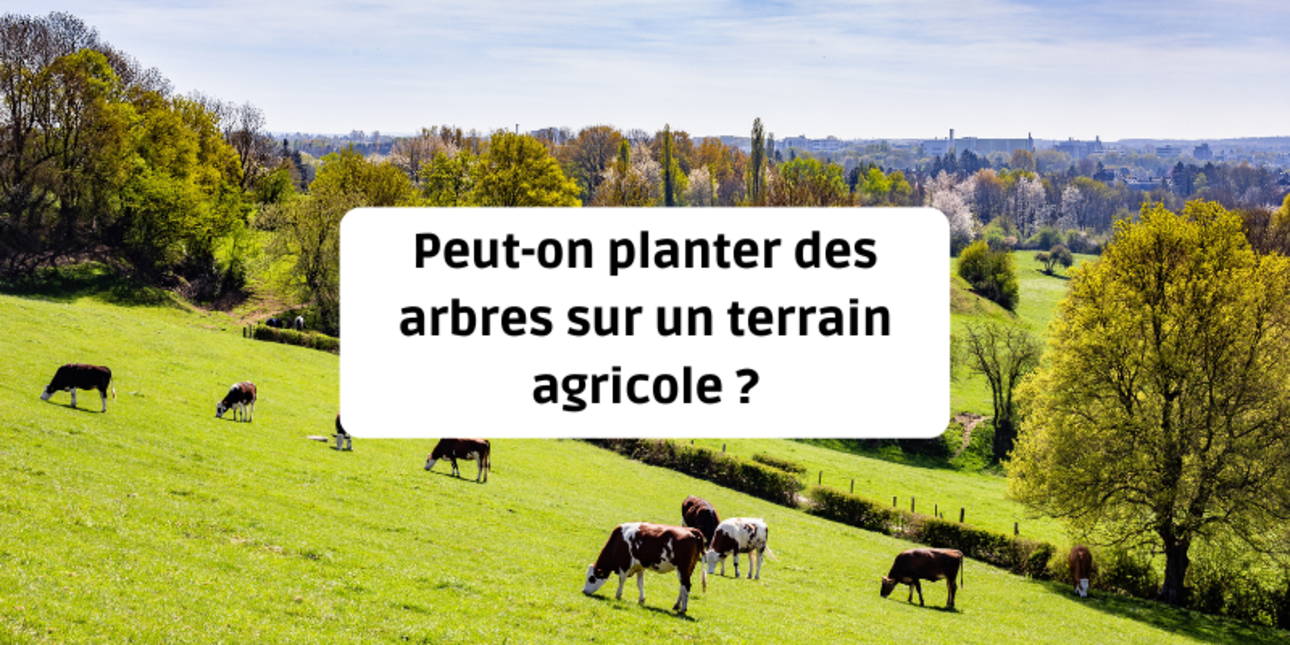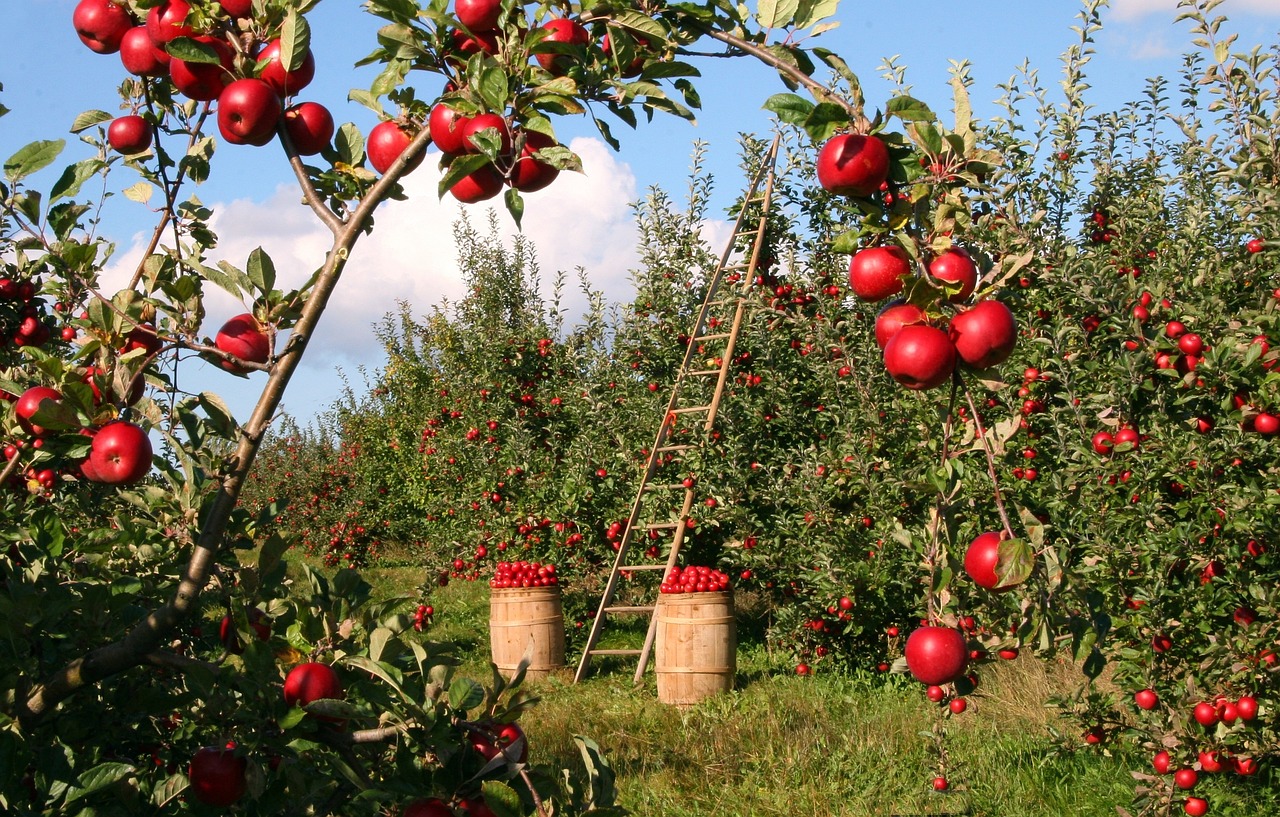
Planting hedges, combining agriculture and tree planting for agroforestry or converting an agricultural plot into woodland, there are several types of planting possible on agricultural land. Not forgetting, of course, arboriculture and horticulture. We present the different possibilities for planting trees on agricultural land.
If you are planning to set up in farming, this is an important point to study and be aware of, particularly in the context of the desired conversion of farming to agro-ecology.
Arboriculture is by definition an agricultural activity. It is therefore not necessary to obtain a specific administrative permit to plant fruit trees on agricultural land.
on agricultural land.
However, as with any agricultural activity, you will need to have a right of use (ownership or rental) over the farmland being farmed, to hold an authorisation to farm under the Control of Structures and to declare your agricultural activity to the Centre de Formalités des Entreprises (Business Formalities Centre) of the Chamber of Agriculture in your department.
Becoming an arboriculturist is a very long-term professional project that requires careful thought.
You must first determine the surface area of your orchard and you must take into account the expected profitability of your fruit trees as well as the amount of work required and therefore your labour needs.
Then you need to think about the marketing and/or processing of your fruit. Do you sell directly? with or without processing? or do you want to sell your production to a single customer? A good knowledge of the local fabric is therefore necessary.
You must then pay close attention to the location of your orchard, as well as to the sunshine, the risk of frost, access to water, etc. The soil must also be fertile and have a pH level that is suitable for the planned production.
You must choose the varieties you wish to plant and check their adaptability to your location and to climatic changes.
Finally, the financial dimension must be studied carefully because the initial investment will be high and it will take several years before you reach a sufficient level of profitability. See our series of articles on "alternative financing tools" to optimise your financing plan.
The activity of a nursery gardener is also an agricultural activity. Apart from building permits for the buildings and installations necessary for production, no specific administrative authorisation is required for the planting of your trees and shrubs.
As with an arborist, the project must be carefully thought out in terms of location, surface area and manpower, as the financial investments are considerable and the activity requires a long time before generating sufficient profitability.
After several decades of destruction, hedges have started to reappear in our rural landscapes in the last 20-30 years. It must be said that their advantages are numerous. They allow :
Built around farm buildings, hedges can be used to hold back a slope, embellish the entrance to a property, hide unsightly elements from view, protect buildings from the wind, etc.
Finally, hedges can be used to produce timber or firewood, but also fruit.
The lease may include specific clauses concerning hedges. It will therefore be necessary to refer to them for all questions concerning the planting, maintenance and destruction of hedges, whether such planting is planned by the lessor or the lessee.
The planting distance between trees is a sensitive issue that can have strong consequences. The regulations will differ depending on the status of each plot.Entre 2 propriétaires privés.
Articles 671 et seq. of the Civil Code determine a minimum distance of 2 metres for trees with a mature height of more than 2 metres and ½ metre for smaller trees. However, local authorities may have stricter rules. You should therefore check with your local council to find out the specific regulations.
It is however possible, with the agreement of both parties, to plant a hedge on a party line.
Along a national, departmental or municipal road
Article R116-2 paragraph 5 of the road code threatens a fine for owners who "In the absence of authorisation, will have established or allowed trees or hedges to grow at less than two metres from the limit of the public road domain". It is therefore necessary to check the exact planting distances by making an alignment request to the road management services.
At the edge of a rural road
Rural roads are part of the private domain of the commune. According to article D161-22 of the Rural Code, "trees and hedges may be planted along rural roads without any distance conditions, provided that the visibility easements and pruning obligations provided for in article D161-24 are respected.
However, in the interests of safety and convenience of passage, the mayor may, by order, designate the roads in his municipality along which plantations must be placed at distances no greater than those laid down for communal roads.
Here again, it is necessary to contact the town hall to find out about local specificities.
Hedges are part of the topographical features that must represent 3% of the Useful Agricultural Area of a farm that applies for aid. It should be noted that, subject to a maximum width, hedge areas can, depending on the department, be counted as part of the surface area of the adjoining crop plot and therefore not lead to a reduction in CAP aid.
The French government has set up a nationwide ‘Planting hedgerows’ programme with €45 million in funding, with the aim of planting 7,000 km of hedgerows between 2021 and 2022. In 2023, an assessment was made of this scheme, with 3,895 dossiers supported for a budget of €44.1m and more than 5,500 linear km planned (4,500 km of hedgerows and 1,000 km of agroforestry).
A new ‘Pacte en faveur de la Haie, un nouvel élan pour la haie à horizon 2030’ was presented by the Minister for Agriculture and the Secretary for Biodiversity on 29 September 2023: with an annual budget of €110 million, it aims to achieve a net gain of 50,000 km of hedgerows nationwide by 2030.
Departmental and regional measures may also exist for the reconstitution of hedges. Consult the Chamber of Agriculture in your department for more information.
Agroforestry consists of combining forestry and agricultural production on the same plot of land.
Trees can be planted in rows within the plot or simply at the edge of the plot, forming hedges.
If the soil is deep enough, the two crops will not compete with each other because ploughing will break the superficial roots of the trees, unlike agricultural crops. On the contrary, according to INRA research, the productivity of wood and crops can increase by up to 30%.
This improvement in production is due to a number of factors, in particular the restructuring of the soil, which facilitates access to water and nutrients for crops, a reduction in runoff and a cooling of the climate, as well as a better dispersion of crop auxiliaries.
However, care must be taken to maintain soil quality and regular pruning of low tree branches must be planned.
As with the planting of hedges, it is important to read carefully what is written in the lease before undertaking any planting. In the absence of a specific clause, you will need to obtain prior authorisation from your landlord for this planting work.
A planted parcel will be considered as agricultural for the purposes of European aid if the density does not exceed 100 trees per hectare and if the stand is evenly distributed over the parcel. Beyond this density, the wooded area must be deducted from the area of the crop for the calculation of the aid.
The implementation of agroforestry systems can benefit from European support. These measures are decided at the level of each French region and it is therefore necessary to contact the Chamber of Agriculture in your department.
Currently, there is support from the EAFRD with a rate of public aid of up to 80% of eligible expenditure for the planting of trees and hedges. Contact your Chamber of Agriculture to find out what support exists in your department.
Forestry income benefits from a very specific regime. However, an agroforestry plot cannot benefit from it as the agricultural use prevails. Income from woodland (or hunting rights) must be included in the farm's agricultural income.
It should be noted that the trees will be capitalised in the balance sheet like any other plantation (arboriculture or viticulture for example).
And property taxes are calculated according to the classification of the agricultural parcel (meadow, ploughing, etc.).
Transforming an agricultural plot into woodland or forest is also a possibility. Beyond a density of 150 trees per hectare, the property becomes a forestry production area and will therefore be concerned by forestry regulations.
becomes a forestry production area and will therefore be concerned by forestry regulations.
Thus, any afforestation of an area greater than 0.5 ha must be subject to a prior request for a case-by-case examination by the Regional Directorate for the Environment, Development and Housing in order to determine whether or not the planned afforestation is subject to environmental assessment.
It should be noted that in each department there may be specific zones for afforestation of plots: free, subject to prior authorisation or prohibited. It is the municipalities concerned that then decide to apply these regulations on their territory. You should contact your local council to find out if your plots are affected.
The website https://www.laforetbouge.fr/ provides a wealth of information and tools to enable you to monitor and manage your woods in conjunction with professionals and the administration.
Each region may have specific aids for afforestation of plots. It is also possible to benefit from aid under the Low Carbon Label for reforestation, the reconstitution of degraded forests and the conversion of coppice into high forest.
It is necessary to contact your Regional Council and to consult the website "la forêt bouge" to identify all the specific schemes for which you can apply.
Income from forest plots benefits from a special regime as the income is flatly equal to the cadastral income of the plots.
Tax measures (DEFI) also allow tax reductions for the acquisition of a forest, the insurance of a forest, the implementation of a management plan and the performance of forestry work.
When an afforestation is carried out, the owner benefits from an exemption from property taxes for a period of 10 years for poplars, 30 years for conifers and 50 years for hardwoods.